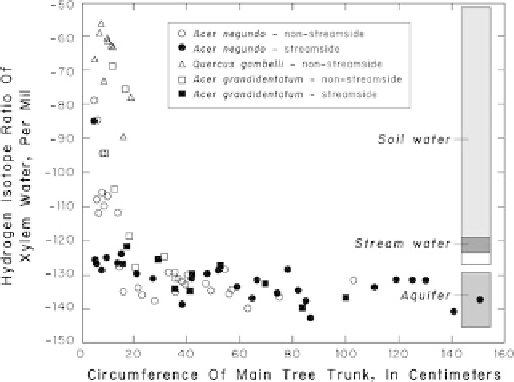Environmental Engineering Reference
In-Depth Information
efficiency of uptake of groundwater and the effectiveness of
the phytoremediation system at sites that experience fre-
quent precipitation, as suggested by Clinton et al. (2004).
However, in areas with low-permeability sediments, the
capture of precipitation in a wetting front suggest that little
to no recharge of the water table will occur, a positive
hydrologic goal at some sites. From a water-budget stand-
point, the loss of efficiency when trees switch from a ground-
water source to a precipitation source is less drastic.
The multiple sources of water used by plants can compli-
cate the analysis of plant-water, stable-H data. To compli-
cate matters even more, some plants such as cacti can store
water from a common or various sources over time, such that
the stable H isotope composition of xylem water will reflect
a mixture of all water sources and will be an average over a
period of time. Isotopic mixing models can be used to
determine the relative contribution of the various water
sources.
Because of the multiple sources of water that are avail-
able to plants, it might be expected that the most obvious
source is the one preferred for use. For example, a long-held
assumption is that trees growing near streams are using
surface water. Many streams, however, consist predomi-
nantly of groundwater discharge, and is the primary source
of water to streams in between precipitation events. Ground-
water is continually in contact with the stream bottom and
can provide a source of water to plants. Dawson and
Ehleringer (1991) measured the stable H isotopes of stream
water, groundwater, precipitation, soil moisture, and xylem
water to show that large trees growing by streams, as well as
larger trees growing some distance from the stream, do not
rely on surface water to meet transpiration demands, as
would be expected (Figs.
9.17
and
9.18
). Rather, the isotopic
composition of the xylem water in the large trees studied was
identical to that of deep groundwater that discharged to
the stream. Conversely, smaller trees contained water
derived from soil water or stream water. A possible explana-
tion for the lack of use of stream water by trees growing
nearby is that groundwater supplying discharge to the stream
is a more constant source of water to which mature root
systems adapt.
As tree root hairs encounter water in the capillary fringe
zone or the water table, transpiration can commence. Stable
isotopes of water have been used to show that trees can
deflect deep groundwater flowlines toward the surface and
can in fact support the growth of nearby plants. This upward
movement of groundwater to the unsaturated zone is called
hydraulic lift (Richards and Caldwell 1987) (Fig.
9.19
).
The physical basis behind hydraulic lift is best explained
in terms of the various components of water potential in the
root zone. In areas where transpiration and evaporation are
removing soil moisture from shallow surface soils, the total
water potentials will decrease, or become more negative.
Fig. 9.17
Stable isotope values of different water sources (Modified
from Dawson and Ehleringer 1991). One centimeter is equivalent to
0.39 in.
Fig. 9.18
Riparian trees often use groundwater rather than surface
water (Modified from Dawson and Ehleringer 1991). Groundwater flow
lines are deflected upward toward the roots and the balance to the
surface water.
Deeper soil with higher, less negative water potentials will
then move upward toward the surface to replenish this lost
water. Much of this action occurs at night when transpiration
and evaporation cease to remove water from the upper soils.



Search WWH ::

Custom Search